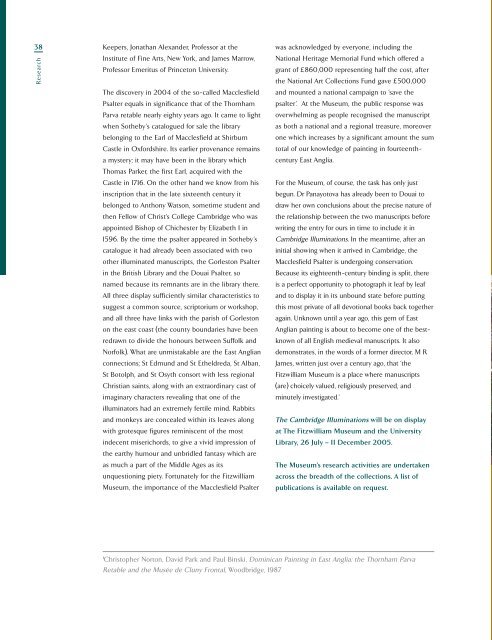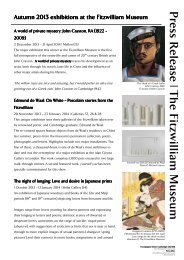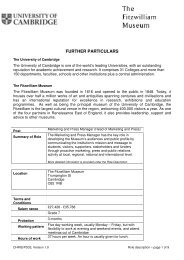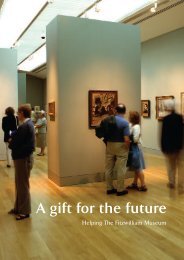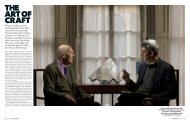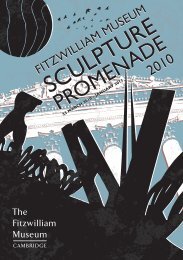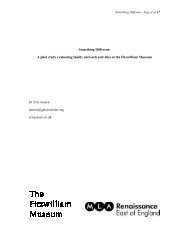The Fitzwilliam Museum - University of Cambridge
The Fitzwilliam Museum - University of Cambridge
The Fitzwilliam Museum - University of Cambridge
Create successful ePaper yourself
Turn your PDF publications into a flip-book with our unique Google optimized e-Paper software.
38 Keepers, Jonathan Alexander, Pr<strong>of</strong>essor at the<br />
Institute <strong>of</strong> Fine Arts, New York, and James Marrow,<br />
Pr<strong>of</strong>essor Emeritus <strong>of</strong> Princeton <strong>University</strong>.<br />
Research<br />
<strong>The</strong> discovery in 2004 <strong>of</strong> the so-called Macclesfield<br />
Psalter equals in significance that <strong>of</strong> the Thornham<br />
Parva retable nearly eighty years ago. It came to light<br />
when Sotheby’s catalogued for sale the library<br />
belonging to the Earl <strong>of</strong> Macclesfield at Shirburn<br />
Castle in Oxfordshire. Its earlier provenance remains<br />
a mystery; it may have been in the library which<br />
Thomas Parker, the first Earl, acquired with the<br />
Castle in 1716. On the other hand we know from his<br />
inscription that in the late sixteenth century it<br />
belonged to Anthony Watson, sometime student and<br />
then Fellow <strong>of</strong> Christ’s College <strong>Cambridge</strong> who was<br />
appointed Bishop <strong>of</strong> Chichester by Elizabeth I in<br />
1596. By the time the psalter appeared in Sotheby’s<br />
catalogue it had already been associated with two<br />
other illuminated manuscripts, the Gorleston Psalter<br />
in the British Library and the Douai Psalter, so<br />
named because its remnants are in the library there.<br />
All three display sufficiently similar characteristics to<br />
suggest a common source, scriptorium or workshop,<br />
and all three have links with the parish <strong>of</strong> Gorleston<br />
on the east coast (the county boundaries have been<br />
redrawn to divide the honours between Suffolk and<br />
Norfolk). What are unmistakable are the East Anglian<br />
connections; St Edmund and St Etheldreda, St Alban,<br />
St Botolph, and St Osyth consort with less regional<br />
Christian saints, along with an extraordinary cast <strong>of</strong><br />
imaginary characters revealing that one <strong>of</strong> the<br />
illuminators had an extremely fertile mind. Rabbits<br />
and monkeys are concealed within its leaves along<br />
with grotesque figures reminiscent <strong>of</strong> the most<br />
indecent miserichords, to give a vivid impression <strong>of</strong><br />
the earthy humour and unbridled fantasy which are<br />
as much a part <strong>of</strong> the Middle Ages as its<br />
unquestioning piety. Fortunately for the <strong>Fitzwilliam</strong><br />
<strong>Museum</strong>, the importance <strong>of</strong> the Macclesfield Psalter<br />
was acknowledged by everyone, including the<br />
National Heritage Memorial Fund which <strong>of</strong>fered a<br />
grant <strong>of</strong> £860,000 representing half the cost, after<br />
the National Art Collections Fund gave £500,000<br />
and mounted a national campaign to ‘save the<br />
psalter’. At the <strong>Museum</strong>, the public response was<br />
overwhelming as people recognised the manuscript<br />
as both a national and a regional treasure, moreover<br />
one which increases by a significant amount the sum<br />
total <strong>of</strong> our knowledge <strong>of</strong> painting in fourteenthcentury<br />
East Anglia.<br />
For the <strong>Museum</strong>, <strong>of</strong> course, the task has only just<br />
begun. Dr Panayotova has already been to Douai to<br />
draw her own conclusions about the precise nature <strong>of</strong><br />
the relationship between the two manuscripts before<br />
writing the entry for ours in time to include it in<br />
<strong>Cambridge</strong> Illuminations. In the meantime, after an<br />
initial showing when it arrived in <strong>Cambridge</strong>, the<br />
Macclesfield Psalter is undergoing conservation.<br />
Because its eighteenth-century binding is split, there<br />
is a perfect opportunity to photograph it leaf by leaf<br />
and to display it in its unbound state before putting<br />
this most private <strong>of</strong> all devotional books back together<br />
again. Unknown until a year ago, this gem <strong>of</strong> East<br />
Anglian painting is about to become one <strong>of</strong> the bestknown<br />
<strong>of</strong> all English medieval manuscripts. It also<br />
demonstrates, in the words <strong>of</strong> a former director, M R<br />
James, written just over a century ago, that ‘the<br />
<strong>Fitzwilliam</strong> <strong>Museum</strong> is a place where manuscripts<br />
(are) choicely valued, religiously preserved, and<br />
minutely investigated.’<br />
<strong>The</strong> <strong>Cambridge</strong> Illuminations will be on display<br />
at <strong>The</strong> <strong>Fitzwilliam</strong> <strong>Museum</strong> and the <strong>University</strong><br />
Library, 26 July – 11 December 2005.<br />
<strong>The</strong> <strong>Museum</strong>’s research activities are undertaken<br />
across the breadth <strong>of</strong> the collections. A list <strong>of</strong><br />
publications is available on request.<br />
1Christopher Norton, David Park and Paul Binski, Dominican Painting in East Anglia: the Thornham Parva<br />
Retable and the Musée de Cluny Frontal, Woodbridge, 1987


